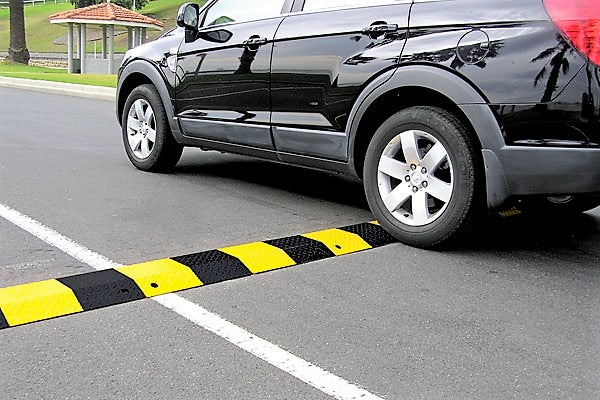Speed bumps are widely used in both commercial and residential areas to slow down traffic and promote safety. For homeowners, speed bumps on driveways are an excellent solution to regulate the speed of vehicles entering or exiting the property, ensuring the safety of pedestrians, pets, and other residents. This article explores the importance, types, benefits, and considerations when installing Speed bumps for driveways, helping homeowners make informed decisions for their properties.
What Are Speed Bumps for Driveways?
A speed bump is a raised area of pavement designed to slow down vehicles. Typically, speed bumps are 3 to 6 inches in height and are spaced strategically across roads, parking lots, and driveways where speed reduction is needed. For residential driveways, speed bumps help reduce the risk of accidents by forcing drivers to slow down, which is particularly important in areas with children, pets, or high foot traffic.
While the terms “speed bump,” “speed hump,” and “speed table” are often used interchangeably, they differ in their size, design, and purpose. Speed bumps are typically shorter and more aggressive in design, intended to make drivers slow down significantly as they pass over them.
Why Install Speed Bumps on Driveways?
- Safety for Pedestrians and Pets
- Residential driveways often experience heavy foot traffic, especially in households with children, pets, or elderly residents. Speed bumps can prevent vehicles from speeding into the driveway, reducing the risk of accidents. Whether it’s children playing outside or pets running around, speed bumps encourage drivers to slow down and be more aware of their surroundings.
- Traffic Control
- Many homes are located in areas with narrow driveways or shared access roads, where speeding vehicles can create hazards. Installing a speed bump forces drivers to slow down, ensuring vehicles do not exceed safe speeds as they enter or exit the driveway.
- Protecting Your Property
- Speed bumps can also help protect your driveway and its surface. Vehicles that speed over the driveway can cause damage over time. By encouraging slower speeds, you reduce the stress on the driveway’s surface, helping to preserve its quality and extend its lifespan.
- Improved Neighborhood Safety
- If you live in a community with shared access driveways, or if your property connects to a busy street, installing speed bumps can improve the overall safety of the neighborhood. It encourages drivers to remain aware of their surroundings and reduce their speed as they approach residential areas.
Types of Speed Bumps for Driveways
Speed bumps for driveways come in a variety of materials, designs, and installation methods. Some of the most popular options include:
- Rubber Speed Bumps
- Rubber speed bumps are one of the most common options for residential driveways due to their ease of installation and durability. Made from recycled rubber, they are environmentally friendly and can be easily placed over an existing driveway surface. Rubber speed bumps are also designed to withstand harsh weather conditions and heavy vehicle traffic.
- Plastic Speed Bumps
- Plastic speed bumps are lightweight and easy to install. These bumps are typically made from high-density polyethylene (HDPE) or similar durable materials. They often come in modular pieces that can be connected to fit the length of the driveway. Plastic speed bumps are durable, resistant to UV rays, and come in bright colors for increased visibility.
- Concrete Speed Bumps
- Concrete speed bumps are a more permanent solution. They are poured directly onto the driveway surface and are ideal for situations where a long-term solution is needed. Concrete speed bumps are more expensive and require professional installation, but they are highly durable and can last for many years without degradation.
- Asphalt Speed Bumps
- Similar to concrete speed bumps, asphalt speed bumps are permanent and long-lasting. However, they tend to blend more seamlessly with existing asphalt driveway surfaces. Like concrete bumps, asphalt speed bumps are also best installed by professionals and are ideal for permanent traffic control.
- Portable Speed Bumps
- For homeowners who require temporary or seasonal traffic control, portable speed bumps are a good option. These speed bumps can be easily removed and reinstalled as needed, making them ideal for driveways that require occasional speed reduction during specific times (e.g., during family gatherings, holidays, or when children are playing outside).
Factors to Consider When Installing Speed Bumps on Your Driveway
While speed bumps provide significant benefits, it’s important to consider several factors before installation to ensure you choose the right solution for your needs.
- Height of the Speed Bump
- The height of the speed bump plays a crucial role in how effective it will be at controlling traffic speeds. Speed bumps typically range from 3 to 6 inches high. Taller bumps are more effective at reducing speed but may be uncomfortable for vehicles, especially for those with low ground clearance. For residential driveways, a 3 to 4-inch high speed bump is typically sufficient.
- Traffic Volume
- The amount of traffic on your driveway will determine how aggressive your speed bump needs to be. If your driveway experiences heavy traffic, especially from larger vehicles, a taller or more substantial speed bump may be necessary. However, if your driveway is rarely used, a smaller speed bump may be sufficient.
- Material Selection
- The material you choose for your speed bump depends on several factors including durability, cost, and appearance. Rubber and plastic speed bumps are cost-effective and easy to install, while concrete and asphalt bumps provide a more permanent, long-lasting solution. Consider your budget and the amount of maintenance you are willing to invest when choosing the material.
- Vehicle Types
- If your driveway is regularly used by large vehicles like trucks, RVs, or delivery vehicles, it’s important to choose a speed bump that can accommodate these larger vehicles without causing significant wear. For such vehicles, a lower profile or more flexible speed bump may be a better choice.
- Visibility and Safety
- To maximize safety, speed bumps should be highly visible, especially at night or during inclement weather. Consider speed bumps with reflective strips, bright colors, or fluorescent markings that will catch the attention of drivers.
Installation of Speed Bumps on Driveways
Installing speed bumps on driveways can range from a simple DIY project to a more complex job requiring professional help, depending on the material and size of the speed bump. Here is an overview of the installation process for various types:
- Rubber or Plastic Speed Bumps
- Preparation: Clean the driveway surface where the speed bump will be installed. Remove any debris or loose material.
- Placement: Position the speed bump in the desired location. Most rubber or plastic speed bumps can be bolted into place using simple tools.
- Securing: Depending on the design, secure the bump with adhesive, screws, or bolts. Many rubber speed bumps come with pre-drilled holes for easy installation.
- Concrete or Asphalt Speed Bumps
- Excavation: A small trench or groove is dug in the driveway where the speed bump will be installed.
- Shaping and Pouring: The speed bump is shaped using molds, and concrete or asphalt is poured into the trench.
- Curing: The material is allowed to cure for several hours or days, depending on the weather and material type.
Cost of Speed Bumps for Driveways
The cost of speed bumps varies widely depending on factors like material, size, and installation method. Here are some average price ranges:
- Rubber Speed Bumps: $50 – $200
- Plastic Speed Bumps: $40 – $150
- Concrete Speed Bumps: $200 – $500
- Asphalt Speed Bumps: $150 – $400
- Portable Speed Bumps: $50 – $100
Conclusion
Speed bumps for driveways are an effective and practical solution for controlling traffic and improving safety. Whether you are concerned about the safety of pedestrians, protecting your property, or controlling the speed of vehicles, installing a speed bump is a worthwhile investment. With various types and materials available, homeowners can select the ideal speed bump for their needs, ensuring both safety and convenience. When installing a speed bump, consider the height, material, traffic volume, and visibility to ensure maximum efficiency.










